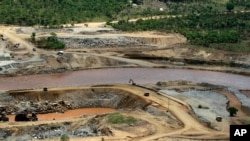Egypt said Monday that Ethiopia has reported it is starting to fill the reservoir of a controversial dam on the Nile River's main tributary, a move likely to increase tensions ahead of a U.N. Security Council meeting on the dispute, which also includes Sudan.
A statement by Egypt's Irrigation Ministry said Minister Mohammed Abdel-Aty received an official notice from his Ethiopian counterpart notifying Egypt of the reservoir filling for the second year.
The statement said Egypt categorically rejects such a "unilateral move," calling it a "clear and grave violation" of a 2015 agreement. It said the move is a threat to region's security and peace.
The U.N. Security Council has scheduled a Thursday meeting to discuss the decadelong dispute over the dam. There has been mounting tensions in recent months after the latest round of African Union-brokered negotiations in April failed to make progress.
Foreign ministers of Egypt and Sudan are in New York to attend the Security Council meeting.
Egyptian President Abdel Fattah el-Sissi warned Ethiopia earlier this year that his government would not tolerate any moves by Addis Ababa that would reduce Egypt's share of water from the Nile. He said that "all options are open" should Egypt's share be touched, urging Addis Ababa to cooperate with Cairo and Khartoum to avert any conflict.
The dam is 80% complete and is expected to reach full generating capacity in 2023, making it Africa's largest hydroelectric power plant and the world's seventh largest, according to reports in Ethiopia's state media.
The dispute now centers on how quickly Ethiopia should fill and replenish the reservoir and how much water it releases downstream in case of a multiyear drought.
Egypt and Sudan have repeatedly called for the U.S., the U.N, and European Union to help reach a legally binding deal that would spell out how the dam is operated and filled.
Egypt, which relies on the Nile for more than 90% of its water supplies, fears a devastating impact if the dam is operated without taking its needs into account. Ethiopia says the $5 billion dam on the Blue Nile is essential, arguing that the vast majority of its people lack electricity.
Sudan wants Ethiopia to coordinate and share data on the dam's operation to avoid flooding and protect its own power-generating dams on the Blue Nile, the main tributary of the Nile.
The Blue Nile meets the White Nile in Khartoum, before winding northward through Egypt to the Mediterranean Sea.








